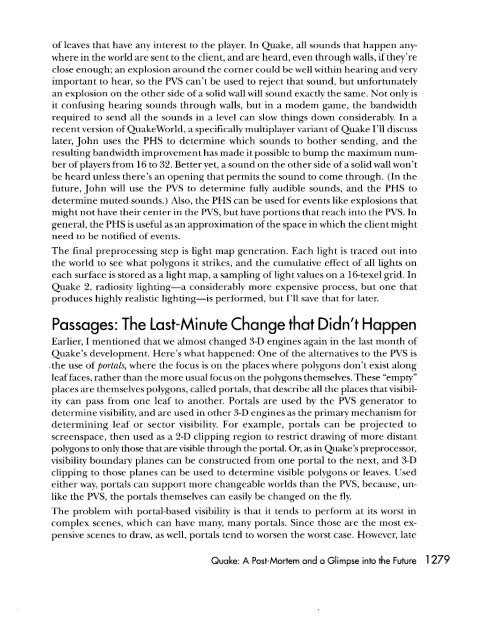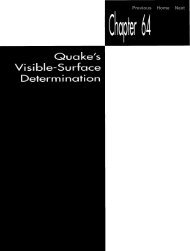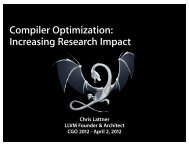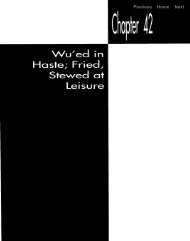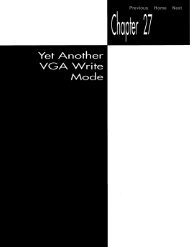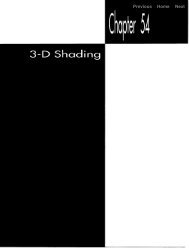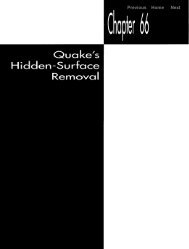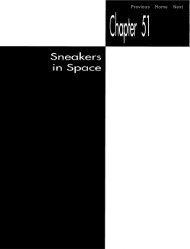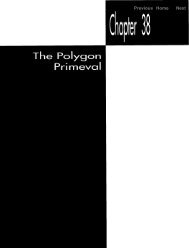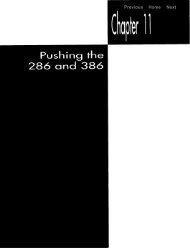quake: a post-mortem and a glimpse into the future
quake: a post-mortem and a glimpse into the future
quake: a post-mortem and a glimpse into the future
Create successful ePaper yourself
Turn your PDF publications into a flip-book with our unique Google optimized e-Paper software.
of leaves that have any interest to <strong>the</strong> player. In Quake, all sounds that happen anywhere<br />
in <strong>the</strong> world are sent to <strong>the</strong> client, <strong>and</strong> are heard, even through walls, if <strong>the</strong>y’re<br />
close enough; an explosion around <strong>the</strong> corner could be well within hearing <strong>and</strong> very<br />
important to hear, so <strong>the</strong> PVS can’t be used to reject that sound, but unfortunately<br />
an explosion on <strong>the</strong> o<strong>the</strong>r side of a solid wall will sound exactly <strong>the</strong> same. Not only is<br />
it confusing hearing sounds through walls, but in a modem game, <strong>the</strong> b<strong>and</strong>width<br />
required to send all <strong>the</strong> sounds in a level can slow things down considerably. In a<br />
recent version of Quakeworld, a specifically multiplayer variant of Quake I’ll d’ lSCUSS<br />
later, John uses <strong>the</strong> PHS to determine which sounds to bo<strong>the</strong>r sending, <strong>and</strong> <strong>the</strong><br />
resulting b<strong>and</strong>width improvement has made it possible to bump <strong>the</strong> maximum number<br />
of players from 16 to 32. Better yet, a sound on <strong>the</strong> o<strong>the</strong>r side of a solid wall won’t<br />
be heard unless <strong>the</strong>re’s an opening that permits <strong>the</strong> sound to come through. (In <strong>the</strong><br />
<strong>future</strong>, John will use <strong>the</strong> PVS to determine fully audible sounds, <strong>and</strong> <strong>the</strong> PHS to<br />
determine muted sounds.) Also, <strong>the</strong> PHS can be used for events like explosions that<br />
might not have <strong>the</strong>ir center in <strong>the</strong> PVS, but have portions that reach <strong>into</strong> <strong>the</strong> PVS. In<br />
general, <strong>the</strong> PHS is useful as an approximation of <strong>the</strong> space in which <strong>the</strong> client might<br />
need to be notified of events.<br />
The final preprocessing step is light map generation. Each light is traced out <strong>into</strong><br />
<strong>the</strong> world to see what polygons it strikes, <strong>and</strong> <strong>the</strong> cumulative effect of all lights on<br />
each surface is stored as a light map, a sampling of light values on a lf5texel grid. In<br />
Quake 2, radiosity lighting-a considerably more expensive process, but one that<br />
produces highly realistic lighting-is performed, but I’ll save that for later.<br />
Passages: The Last-Minute Change that Didn’t Happen<br />
Earlier, I mentioned that we almost changed 3-D engines again in <strong>the</strong> last month of<br />
Quake’s development. Here’s what happened: One of <strong>the</strong> alternatives to <strong>the</strong> PVS is<br />
.<strong>the</strong> use of portals, where <strong>the</strong> focus is on <strong>the</strong> places where polygons don’t exist along<br />
leaffaces, ra<strong>the</strong>r than <strong>the</strong> more usual focus on <strong>the</strong> polygons <strong>the</strong>mselves. These “empty”<br />
places are <strong>the</strong>mselves polygons, called portals, that describe all <strong>the</strong> places that visibility<br />
can pass from one leaf to ano<strong>the</strong>r. Portals are used by <strong>the</strong> PVS generator to<br />
determine visibility, <strong>and</strong> are used in o<strong>the</strong>r 3-D engines as <strong>the</strong> primary mechanism for<br />
determining leaf or sector visibility. For example, portals can be projected to<br />
screenspace, <strong>the</strong>n used as a 2-D clipping region to restrict drawing of more distant<br />
polygons to only those that are visible through <strong>the</strong> portal. Or, as in Quake’s preprocessor,<br />
visibility boundary planes can be constructed from one portal to <strong>the</strong> next, <strong>and</strong> 3-D<br />
clipping to those planes can be used to determine visible polygons or leaves. Used<br />
ei<strong>the</strong>r way, portals can support more changeable worlds than <strong>the</strong> PVS, because, unlike<br />
<strong>the</strong> PVS, <strong>the</strong> portals <strong>the</strong>mselves can easily be changed on <strong>the</strong> fly.<br />
The problem with portal-based visibility is that it tends to perform at its worst in<br />
complex scenes, which can have many, many portals. Since those are <strong>the</strong> most expensive<br />
scenes to draw, as well, portals tend to worsen <strong>the</strong> worst case. However, late<br />
Quake: A Post-Mortem <strong>and</strong> a Glimpse <strong>into</strong> <strong>the</strong> Future 1279


